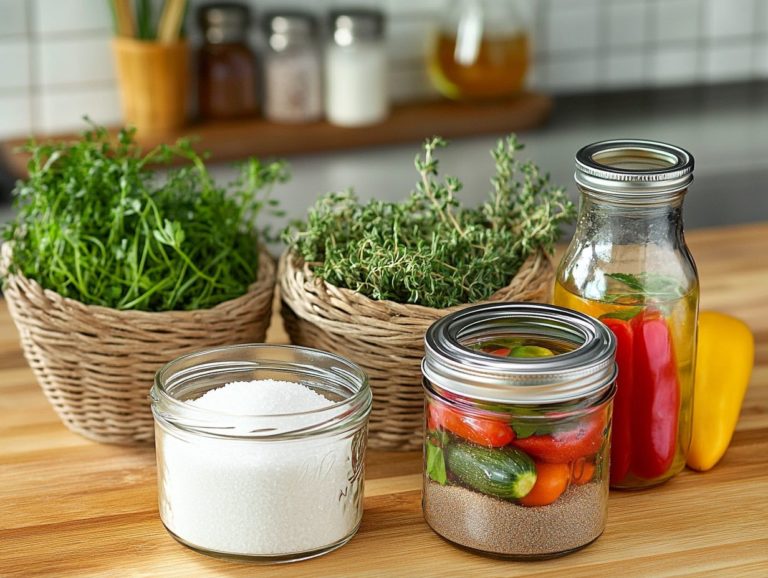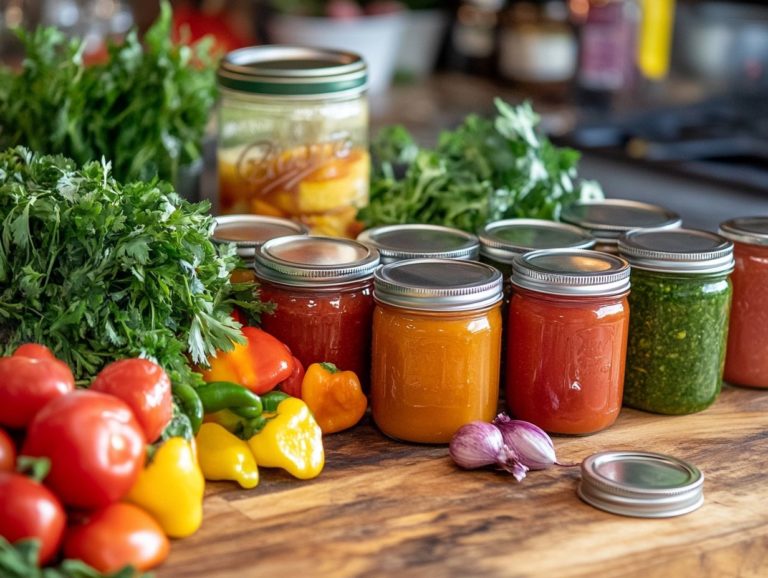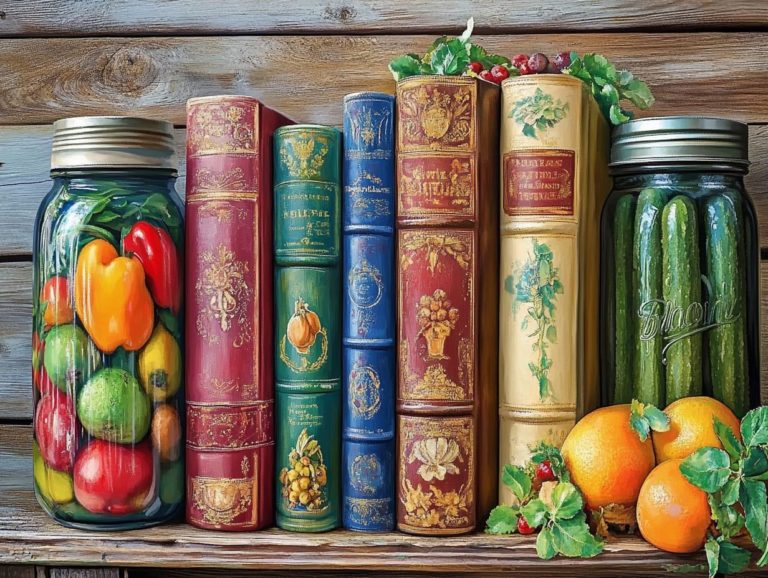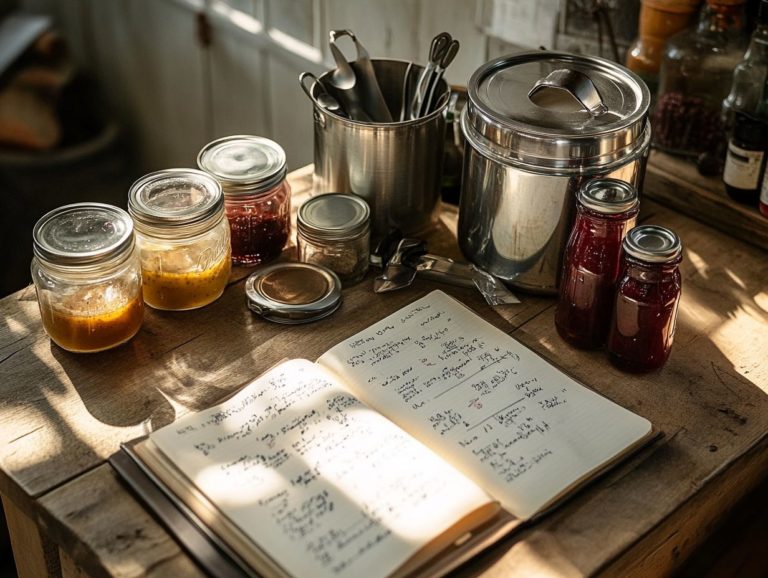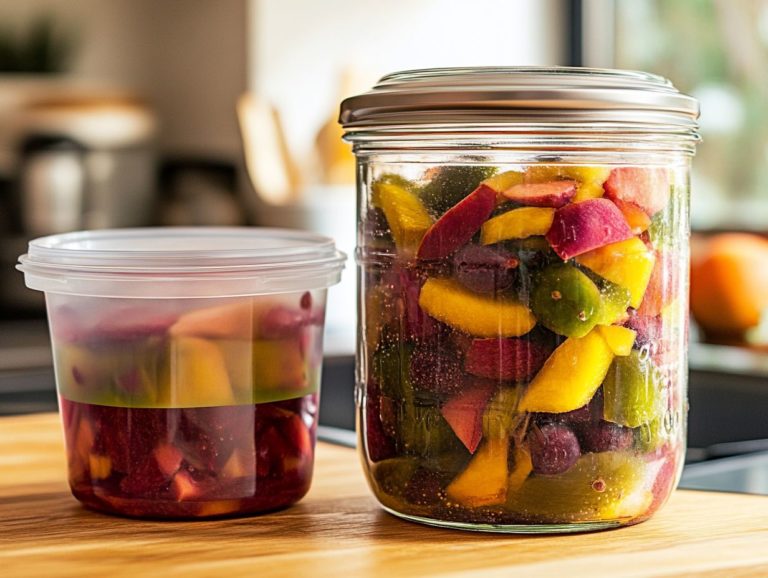Canning Equipment Maintenance Checklist
Canning is a cherished tradition that enables you to preserve the vibrant flavors of the season. It begins with ensuring your equipment is well-maintained.
A simple oversight can lead to spoilage or food safety concerns, which is the last thing you want. This guide offers a comprehensive maintenance checklist to ensure your canning tools are in peak condition.
From inspecting jars and lids to thoroughly cleaning your canning pot, every crucial step is outlined. This empowers you to embrace your canning experience with utmost confidence.
Contents
- Key Takeaways:
- 1. Clean and Sanitize All Equipment Before Use
- 2. Inspect Jars for Cracks or Chips
- 3. Check Lids for Damages or Rust
- 4. Ensure Rings Are Not Bent or Damaged
- 5. Test Pressure Canner Gauge
- 6. Clean and Lubricate Canning Tools
- 7. Check Seals on Jars
- 8. Inspect Canning Rack for Rust or Damage
- 9. Test Canning Funnel for Proper Fit
- 10. Check for Any Loose or Missing Parts
- 11. Clean and Inspect Canning Pot
- 12. Check for Any Leaks in Pressure Canner
- 13. Inspect Rubber Gasket on Pressure Canner
- 14. Clean and Sanitize Storage Area for Canning Equipment
- 15. Properly Store Canning Equipment After Use
- Frequently Asked Questions
- What is a canning equipment maintenance checklist?
- Why is it important to have a canning equipment maintenance checklist?
- What should be included in a canning equipment maintenance checklist?
- How often should a canning equipment maintenance checklist be performed?
- Can I create my own canning equipment maintenance checklist?
- What should I do if I notice any issues during my canning equipment maintenance check?
Key Takeaways:
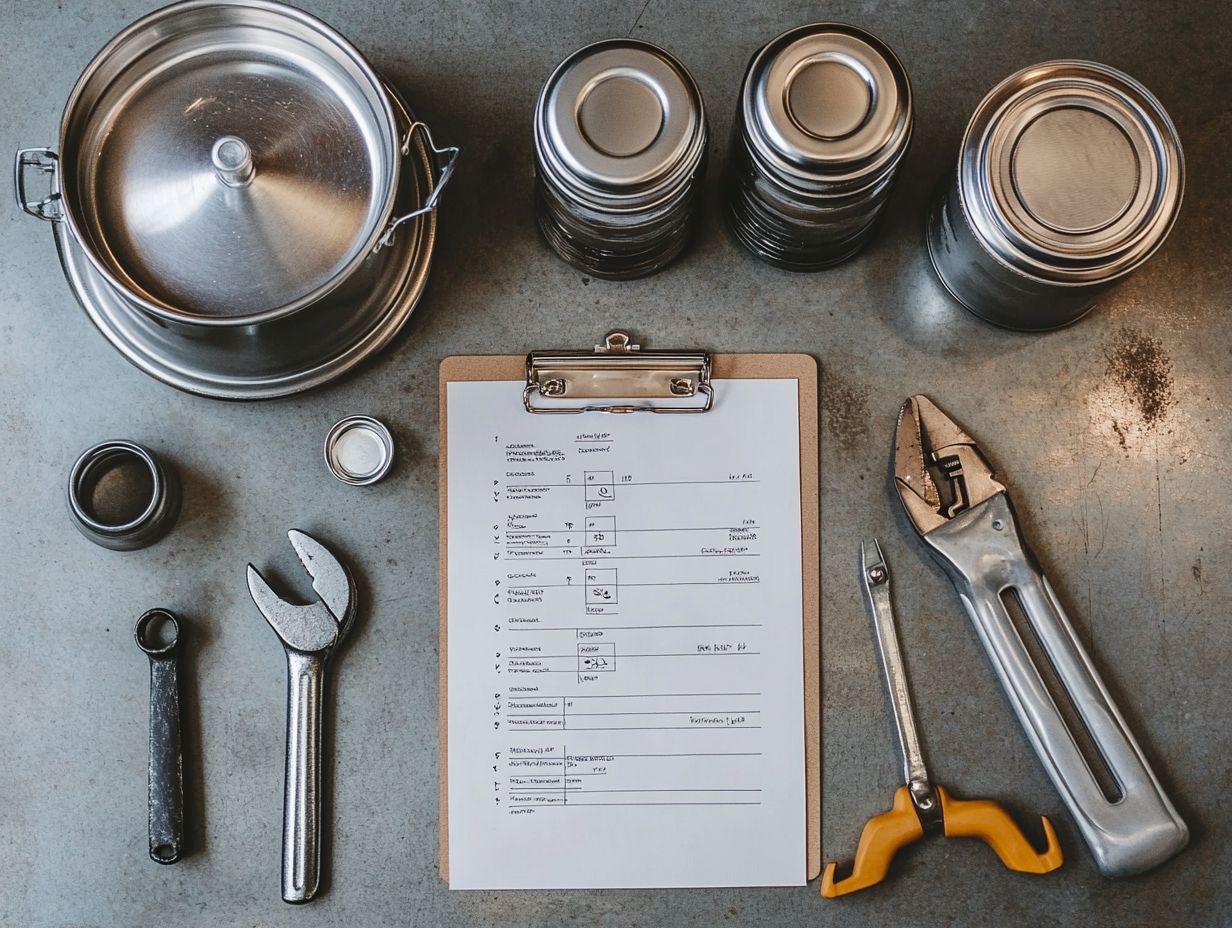
- Clean and sanitize all equipment before use to prevent contamination and ensure safe canning.
- Regularly inspect jars, lids, rings, and other equipment for damages to avoid potential hazards and spoilage.
- Properly clean, lubricate, and store canning tools to ensure their longevity and effectiveness in the canning process.
1. Clean and Sanitize All Equipment Before Use
Before you immerse yourself in the rewarding realm of home canning, it s essential to thoroughly clean and sanitize all your canning equipment special pots for canning food under pressure, jars, and various supplies.
This first step is your gateway to delicious, safe canning! A pristine workspace is paramount for successful canning; even the tiniest speck of dirt or bacteria can spoil jars filled with your lovingly prepared produce.
To effectively clean each item, start by washing your jars and lids in hot, soapy water. Rinse them thoroughly and let them air dry. For pressure canners, scrub the interior surfaces with a mild detergent before rinsing.
Sanitizing can easily be accomplished with a mixture of vinegar and water or a commercial sanitizer, both of which will eliminate any lingering pathogens. Cleaning regularly safeguards the quality of your preserved items and instills confidence in your canning process.
2. Inspect Jars for Cracks or Chips
Inspecting your canning jars for cracks or chips is essential in the home canning process. Even the smallest imperfections can lead to unsealed jars and compromise your food preservation efforts.
Ensuring the integrity of these jars not only safeguards food quality but also enhances your chances of canning success. Take the time to check each jar thoroughly, paying special attention to the rim and shoulders.
When handling the jars, use clean hands or gloves to prevent transferring any oils or residues that might interfere with the sealing process. After you ve finished inspecting, ensure the jars are free of dust or debris by washing them thoroughly before filling.
Store your jars properly, away from direct sunlight and extreme temperatures, to maintain their condition for future use.
3. Check Lids for Damages or Rust
Checking your lids for damages or rust is a crucial step you can’t overlook in mastering canning best practices. Neglecting this could compromise the seal and put food safety at risk.
If you spot warping, dents, or rust, replace those lids immediately to keep your food safe! Compromised lids can result in spoilage or contamination, rendering your food unsafe to eat.
Examine each lid closely before use, looking for imperfections or signs of wear. Regular maintenance is key storing lids in a cool, dry place, away from moisture, will help extend their lifespan.
Should you discover a compromised lid, replacing it without delay is essential to safeguarding your canned goods. Stay vigilant, and your canned goods will reward you with freshness and flavor!
Get started on your canning journey today and enjoy the fruits of your labor!
4. Ensure Rings Are Not Bent or Damaged
Ensuring your canning rings are straight and undamaged is essential for a reliable seal on your jars. Any imperfections can cause spoilage and food safety issues during the canning process.
Before starting your canning, inspect each canning ring carefully. Look for warping, rust, or damage that might jeopardize the seal. A damaged ring increases spoilage risk and can lead to contamination, threatening all your hard work.
Store your rings in a cool, dry place to prevent rust. Always keep your rings clean before use; this simple step boosts their sealing power and extends the lifespan of both the rings and your canned goods.
5. Test Pressure Canner Gauge

Testing your pressure canner gauge keeps pressure levels accurate while canning. An inaccurate gauge can lead to improperly processed food, creating risks for spoilage and health hazards.
Check the gauge at least once a year or right before the canning season. You can typically do this through a pressure gauge testing service, available at local Extension offices or canning equipment retailers.
If you prefer testing at home, submerge the gauge in water at a known pressure for a reliable initial check. Note any discrepancies, as even slight inaccuracies can result in under-processing.
Maintain your equipment regularly; if the gauge shows consistent deviation, it s wise to replace it. This helps guarantee the safety and quality of your preserved goods.
6. Clean and Lubricate Canning Tools
Cleaning and lubricating your canning tools, like jar lifters and bubble removers, with food-safe grease ensures their longevity and optimal performance during the canning process.
By maintaining these tools, you prolong their life and ensure they function safely and effectively. A thorough cleaning includes washing the tools in warm, soapy water, rinsing them, and allowing them to air dry completely.
For lubrication, use food-safe greases, such as those made from white lithium or silicone. These greases withstand high temperatures and resist contamination, ensuring your tools remain safe to use year after year.
7. Check Seals on Jars
Checking the seals on your jars after canning is critical. This step ensures the jars are properly sealed, preventing spoilage and guaranteeing successful food preservation.
To verify proper seals, gently press down in the center of the lid; if it springs back, something might be wrong. For any unsealed jars, reprocess the contents with a new lid or refrigerate and consume the food promptly.
This procedure extends the shelf life of your preserved items and enhances safety, helping you avoid foodborne illnesses and waste.
8. Inspect Canning Rack for Rust or Damage
Inspecting the canning rack for rust or damage is essential, as it impacts the stability and safety of your jars during the canning process, especially when using a boiling water method.
Any deterioration of the rack can cause mishaps, like jars tipping over or breaking. This leads to wasted food and safety hazards. Regularly check for corrosion, bent sections, or loose fittings that might compromise the rack’s structure.
Clean the rack thoroughly after each use with mild soap and water, ensuring it s completely dry before storage to prevent moisture buildup. Consider applying a protective coating to extend its lifespan and maintain its integrity. This proactive approach makes your canning experience safer and more enjoyable.
9. Test Canning Funnel for Proper Fit
Testing the canning funnel for a proper fit is essential when you’re filling jars. An ill-fitting funnel can lead to spills and improper filling, complicating your canning process in ways you d rather avoid.
When you ensure that the funnel fits snugly against the jar opening, you not only save time but also minimize mess. This creates a more efficient canning experience.
A well-fitting funnel directs ingredients neatly into the jar, preserving the quality of your contents and preventing waste.
When selecting a canning funnel, take into account the sizes of the jars you’ll be using; some funnels are specifically designed for wide-mouth jars, while others cater to standard sizes.
It’s also smart to test the funnel against various jar openings in advance, as some may have subtle variations. This simple step can streamline your jar-filling process and significantly enhance your overall results.
10. Check for Any Loose or Missing Parts
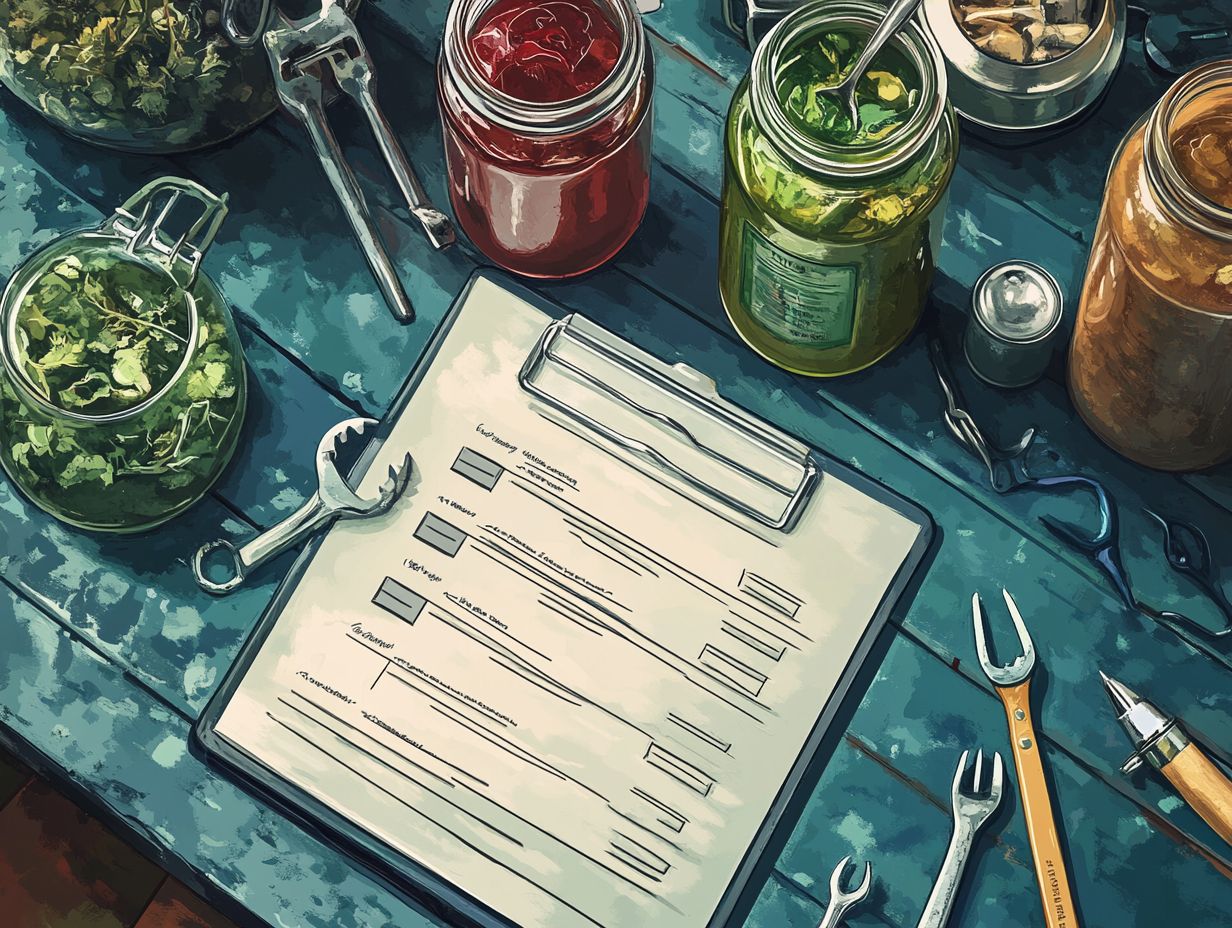
Checking for any loose or missing parts in your canning equipment is crucial to ensure the safe and effective operation of your setup during the home canning process. Additionally, knowing how to properly clean canning equipment is essential for maintaining its functionality.
A thorough inspection not only prevents potential equipment failure but also guarantees that your preserved foods remain safe for consumption.
Without proper maintenance, pressure canning and water bath canners can jeopardize the quality of your preserves and potentially pose serious health risks.
To safeguard your efforts, develop a routine checklist that focuses on key components:
- The lid and gasket of pressure canners, ensuring they seal properly;
- The safety valve, to confirm it’s functioning;
- The jars (including canning jars) themselves, checking for cracks or chips.
Inspect the water bath canner s heating element and ensure the canning rack is in good condition to help minimize potential issues. Utilize a clean canner approach to maintain your equipment.
11. Clean and Inspect Canning Pot
Cleaning and inspecting your canning pot is an essential step in maintaining your canning equipment. A pristine pot guarantees even heat distribution and minimizes the risk of food contamination.
Regular maintenance enhances safety during the canning process and extends the lifespan of your pot, especially when you consider the key features to look for in canning equipment.
Begin by removing any lingering food particles or rust that may have collected after use. A simple solution of warm, soapy water will effectively cleanse the interior surfaces, while a gentle scrubbing pad tackles those stubborn spots.
Once you’ve rinsed thoroughly, inspect the seals and the bottom for any signs of wear. Addressing these details now will pave the way for successful canning endeavors in the future.
12. Check for Any Leaks in Pressure Canner
Checking for any leaks in your pressure canner is crucial for ensuring food safety. A leak can prevent the canner from reaching the necessary pressure, putting your food processing at risk.
Improper processing could lead to spoilage or even dangerous bacterial growth, posing severe health risks to anyone consuming those preserved foods.
To effectively check for leaks, inspect the gasket and lid for visible signs of wear, damage, or improper sealing.
A simple water test can also work wonders just use boiling water to create steam, making it easier to spot any escaping air or moisture.
If you find any leaks, replace the faulty gasket or make the necessary adjustments to restore your pressure canner’s functionality. Don’t let a small leak ruin your canning efforts act now!
13. Inspect Rubber Gasket on Pressure Canner
Inspecting the rubber gasket on your pressure canner is crucial. A worn or damaged gasket can lead to loss of pressure in the canner, jeopardizing both the canning process and food safety.
Regular checks help you spot any signs of wear, like cracks, tears, or loss of pliability. These issues can compromise the canner s effectiveness. Replacing the gasket when necessary is vital for maintaining proper pressure levels and ensuring that your preserved food stays safe for consumption over time.
To maintain the gasket, clean it after each use and store the canner in a cool, dry place. This prevents degradation from moisture and heat. By proactively following these maintenance tips, you can extend the life of the gasket, ensuring more successful canning sessions for all your culinary endeavors.
14. Clean and Sanitize Storage Area for Canning Equipment
Cleaning and sanitizing the storage area for your canning equipment is just as vital as maintaining the equipment itself. You want to ensure that your supplies are free from dust and contaminants.
A well-kept environment significantly impacts the quality of the jars, lids, and other essential canning items you depend on. Regularly checking the cleanliness of this space helps avoid the buildup of grime and bacteria that could jeopardize the integrity of your carefully prepared goods. Additionally, being aware of signs your canning equipment needs replacement is crucial for maintaining safe canning practices.
Make it a habit to clear out expired materials, organize your items efficiently, and choose cleaning products that are safe to use near food. Prioritizing this routine protects your canning supplies and creates a more efficient and enjoyable workspace for all your preservation projects.
15. Properly Store Canning Equipment After Use
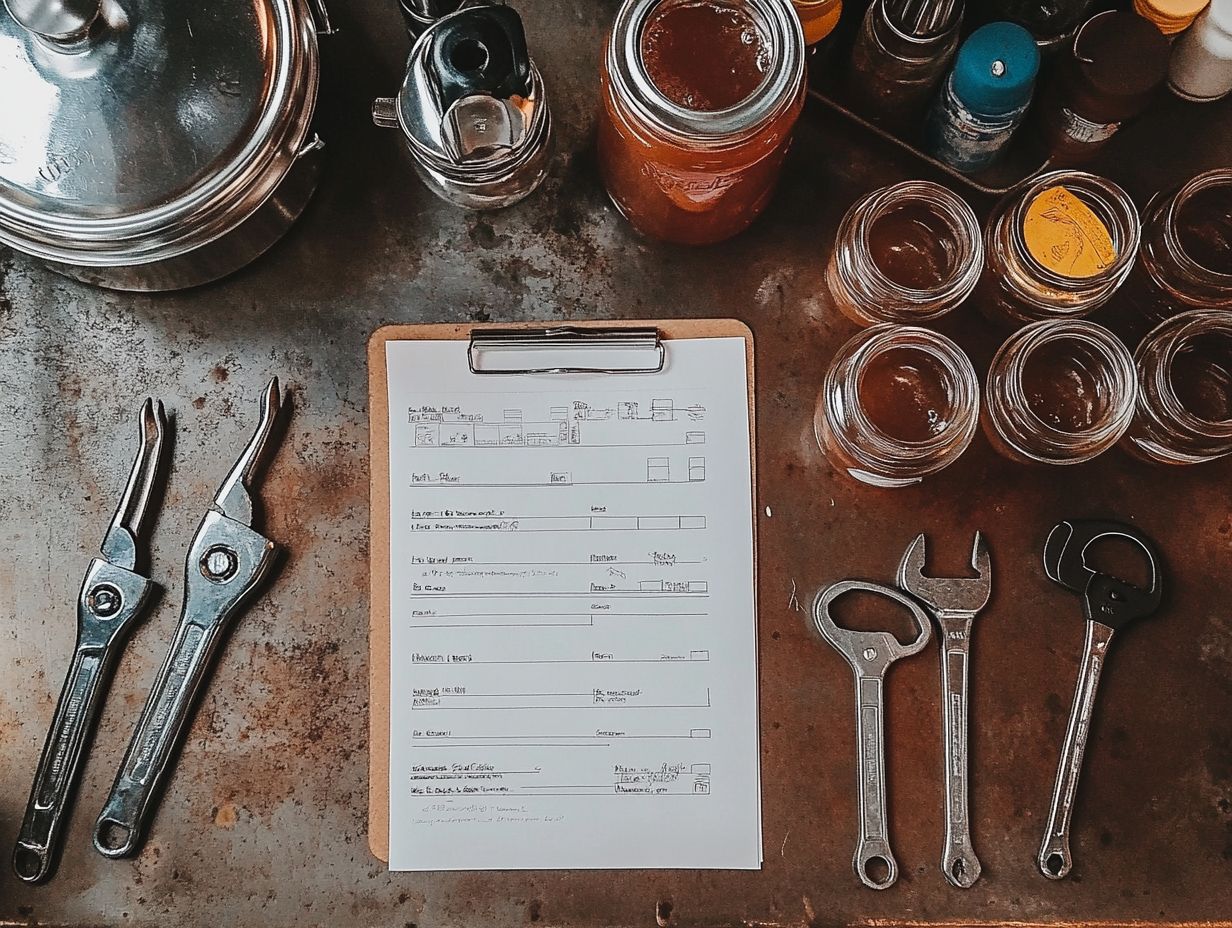
Storing your canning equipment properly after use is vital for prolonging its lifespan and ensuring optimal performance in your future canning recipes.
Taking the time to arrange your items thoughtfully can prevent damage and ensure everything is ready for your next round of preserving. For example, thoroughly cleaning your pressure canners is essential to eliminate any food residue and moisture that could lead to rust.
Canning jars should be stored in a cool, dry place, preferably upright, with lids separated to avoid corrosion. Using bubble wrap or cloth between jars adds that extra cushion to safeguard against breakage.
Organizing your tools in labeled containers allows for quick access and helps maintain an efficient workspace when canning season returns.
Frequently Asked Questions
What is a canning equipment maintenance checklist?
A canning maintenance checklist lists tasks to keep your equipment safe and functional.
Why is it important to have a canning equipment maintenance checklist?
Having a canning maintenance checklist helps ensure that your equipment is in good working condition, reducing the risk of equipment failure or contamination of canned goods. For detailed guidance, check out how to maintain your canning equipment.
What should be included in a canning equipment maintenance checklist?
A canning maintenance checklist should include tasks such as cleaning, inspections, lubrication, and any other necessary maintenance procedures specific to your equipment, including essential safety checks for canning equipment.
How often should a canning equipment maintenance checklist be performed?
The frequency of performing a canning maintenance checklist depends on the type of equipment and how often it is used. However, it is recommended to refer to crafting your own canning supply checklist and perform maintenance at least once a month.
Can I create my own canning equipment maintenance checklist?
Yes, you can create your own canning maintenance checklist by referring to the manufacturer’s instructions and recommendations, along with any additional tasks specific to your equipment. For guidance on this, check out how to repair common canning equipment.
What should I do if I notice any issues during my canning equipment maintenance check?
If you notice any issues during your canning maintenance check, such as damaged parts or unusual noises, address them immediately. For further guidance, refer to this guide on evaluating used canning equipment or contact the manufacturer or a qualified technician for assistance if needed.


